This is the third installment in our five-part series on “The Great Farm and Food Talent Search,” a look at the workforce issues facing American agriculture. Part one of the series focused on the search for the next generation of agricultural employees and part two discussed ways companies are looking beyond just salaries to retain and recruit workers.
Brittany Williams has moved away three times from her hometown of Haskell, Texas, but the dusty roads of the ranching and cotton-growing area north of Abilene kept bringing her back. Today, she has a mission to do nothing less than “end generational poverty in rural America.”
She started teaching in 2007 and quickly discovered students were graduating without basic life skills and instead "taught to the test."
She's now director of continuing education for Texas-based Collegiate Edu-Nation, or CEN, where she serves 21 rural school districts across the 12 Texas AgriLife Extension districts.
CEN — which started in 2008, with 294 students in the west Texas town of Roscoe, where half the student population is Hispanic — is one of many ways that colleges, companies, organizations and others around the country are employing innovative thinking and training to develop the next generation of ag and food employees.
Apprenticeships, workforce training, career development and onboarding employees all offer ways for companies to build their future workforce with the talent needed to meet the growing projected job opportunities in the agricultural sector.
“For years, school districts have been catering to the affluent, easy students, straight-A students. What about the other 95%? What are we doing for them? And where are they going?” Williams asked. “Right here in my hometown, I sit here, and I ask, ‘What can we do to motivate them to want to be better and want to serve a life with purpose?’”
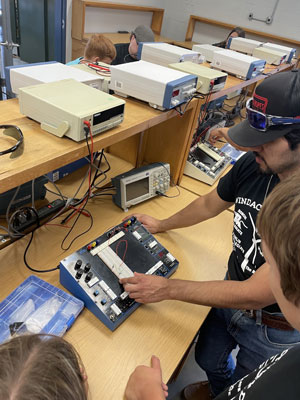 Students experiencing hands-on learning through CEN program.
Students experiencing hands-on learning through CEN program.
“I always go back to the thought that we’ve got to save rural,” she added.
CEN's Science, Technology, Engineering and Math (STEM) and Pathways in Technology Early College High Schools (P-TECH) model helps create a pathway to success for many low-income students who may not have the family home support system or finances as their urban counterparts. In 2022, Roscoe Collegiate enrollment had grown to 625, and the program has been adopted in other states.
Ninety percent of the graduating high school students in Roscoe who participated in CEN have obtained an associate degree or workforce certification, at no cost to them through a partnership with West Texas A&M University in Canyon.
CEN training can continue into adulthood through postsecondary and CEN’s Registered Apprenticeship Program that's designed to avoid the burden of schooling costs or living away from home.
Public-private partnerships have been essential to the success of the program.
In Texas, a P-TECH 9-14 school model created by IBM provides youth with the academic, technical and professional skills often lacking in today’s workforce. The public-private partnership allows CEN to create model businesses at the schools to provide hands-on experience and certification training. The businesses go by names such as Edu-Vet, Edu-Drone or Edu-Weld.
The Edu-Vet business partnered with a veterinarian at Texas A&M and an embryologist to teach students as they earned their vet-tech and embryology certification with hands-on experience artificially inseminating cattle.
Partnerships help close skills gap
Just as those Edu-businesses in schools in Texas seek to create new training opportunities, workforce development is seeing a revival across the country as businesses realize conventional approaches do not always prepare future workers for current labor needs.
Companies are having to ensure talent strategies for hiring and developing workers fill a firm's business needs, said Julie Davis, senior director of workforce and industry initiatives at the Association of Equipment Manufacturers.
“If you don’t have somebody that can bring HR to the C-suite table and help align the talent strategy with your business strategy, you’re not going to win that war for talent,” Davis said.
Companies can partner with educational institutions and also identify training curricula. “Evolving educational and skills training with education and partners is a tremendous opportunity. I’m excited to see the industries that are actively doing that because they’re going to win in a big way,” Davis said.
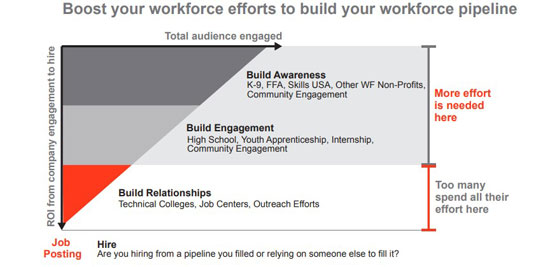 Graphic: AEM
Graphic: AEM
Working through high schools and youth apprenticeship programs and programs such as FFA can also help companies develop a pipeline of new talent.
The 4-H program, which is more than a century old, also has a role to play. The 4-H program offers agricultural experiences for 6 million youth with hands-on projects in such areas as health, science, agriculture and leadership, and 4-H chapters are increasingly available in urban centers.
Powered by America’s leading land-grant universities and Cooperative Extension System, 4-H programs offer viable career pathways in many new areas like computer science, drone technology, biology, environmental science, food science, seed technology, sustainability and more, said Jill Bramble, chief growth officer and new CEO for the National 4-H Council. “4-H’ers begin learning about agriculture careers as early as eight years old, engaging in diverse programming that helps them find their spark,” she added.
The 4-H Tech Changemakers and 4-H CS Pathway prepare young people for the workforce by providing relevant computer science and digital skills education, opportunities to lead and a sense of responsibility for giving back, Bramble said.
In recent years, agribusiness giants Bayer, Corteva Agriscience, Nutrien and Nationwide have supported the 4-H Youth Summit Agri-Science held in Washington, D.C., in March. While at the summit, teams of high school students from across the country create action plans to address challenges in their communities with agriculture and science-based solutions. They then return home to put those plans into action.
Another well-known program trying to deepen the connection between science and agriculture is the National FFA Organization.
“Hands-on learning has been part of the FFA and agriculture education DNA for nearly a century,” said National FFA CEO Scott Stump.
FFA offers agricultural, food and natural resources learning experiences for more than 945,000 members ages 12 through 21 in more than 9,000 chapters at about one-third of the high schools nationwide.
As the rural population continues to shrink, there is an “exponentially growing need” to get more young people thinking about roles in the food and ag sectors, Stump told Agri-Pulse.
“Our job is to reclaim those who may not have a direct connection to agriculture and invite them back into the food value chain as a farmer, rancher, chemist or engineer, who’s going to solve the big food problems in the world.”
One of the largest FFA chapters is located at the Chicago High School of Agricultural Sciences, which combines college preparatory classes with six ag career pathways, using the FFA model of classroom education, supervised agricultural experiences (SAE) and engagement in the organization. Principal Bill Hook said the program is also helping schools in eight other cities, including Memphis and Milwaukee, copy the Chicago model.
Don't miss a beat! Sign up for a FREE month of Agri-Pulse news! For the latest on what’s happening in agriculture in Washington, D.C. and around the country, click here.
As many as 2,000 Chicago students apply to the school each year, 200 of whom are accepted. During their first year, they take an Ag Careers and Leadership class that helps dispel myths about agriculture and exposes students to some of the 300 careers in agriculture.
Some 35% to 40% of the Chicago chapter members continue to college to pursue an agriculture degree, Hook said.
Of the 1% of FFA members who receive the organization's highest honor — the American Degree, which requires completing an SAE program and 50 community service hours — a large majority wind up in the ag workforce, Stump said.
FFA launched a career exploration tool called AgExplorer for students to take an inventory of their interests and identify what careers may best suit them. Stump said FFA has identified skill gaps with industry partners in the career areas of sustainability and tech and is creating new hands-on experiences to teach an expanding skill set necessary for future jobs.
Gracie Murphy, an Illinois native currently serving as FFA's eastern region vice president, has spent time working with sponsoring agricultural companies to hear their needs for the future ag workforce and help craft experiential learning opportunities for FFA participants.
Herself one generation removed from the farm, Murphy said FFA showed her there are careers that support the ag industry. She plans to major in agricultural education and appreciates her now-expanded understanding of the many career opportunities that she can pursue.
FFA is “not just telling students the careers available but showing them and connecting them with mentors who are going to help them through the process of having these students figure out what they want to do for the rest of their lives,” Murphy said.
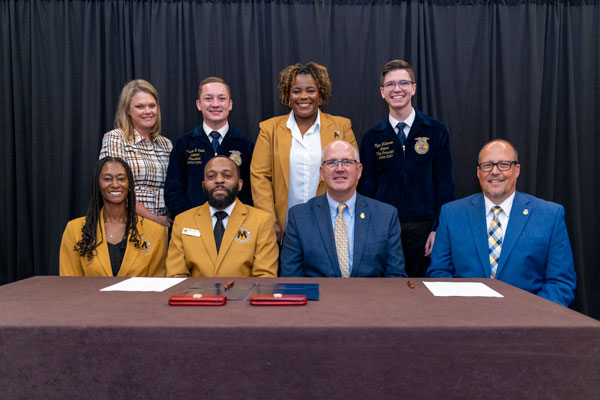 FFA and MANNRS leaders at the signing of an MOU between the two organizations.
Many companies also partner with FFA and local schools to enhance agricultural education efforts. The CHS Foundation, for example, awarded $75,000 in grants for K-12 teachers to implement projects to allow students experiential agricultural education.
FFA and MANNRS leaders at the signing of an MOU between the two organizations.
Many companies also partner with FFA and local schools to enhance agricultural education efforts. The CHS Foundation, for example, awarded $75,000 in grants for K-12 teachers to implement projects to allow students experiential agricultural education.
In addition to 4-H and FFA, another expanding organization to connect and recruit those outside of the traditional ag circles is MANNRS — Minorities in Agriculture, Natural Resources and Related Sciences, which has 70 university chapters across the country in 39 states.
A main focus of MANNRS is sharing basic ag literacy skills and expanding early career awareness about agriculture for minority students as they move from elementary school and on to higher education, Ebony Webber, MANNRS' chief officer of operations.
MANNRS’ model statement is “changing the face of agriculture by linking hands around the world,” Webber said. The organization has grown through partnerships at all levels with companies, universities and schools.
“Through our university connections, we recognize that we have the unique ability to be a convener to bring together trade organizations, corporate organizations, government agencies, university partners and high schools to serve in a unique capacity of being able to bring key stakeholders to the table and have a conversation,” she said.
“We’re working directly with corporate partners to influence their DEI (diversity, equity and inclusion) strategies, their recruitment strategy and some of their development opportunities for their minority and diverse employees within their company,” Webber said.
MANNRS has partnered with the National Grain and Feed Association to annually award $10,000 scholarships for three students, which supports attendance at NGFA's networking annual meeting and NGFA's Advocacy Day on Capitol Hill event.
One grant recipient, Ernest Dixon III, said the exposure to the grain industry helped him land a job at Cargill. He said experience and exposure are the two components missing today for future agricultural workers.
Professional apprenticeships expanding in ag fields
Apprenticeships offer another important way to connect future employees with employers and target specific on-the-job training with specialized schooling.
In 2015, Zurich North America started looking at whether the apprenticeship model long used at the Switzerland-based Zurich Insurance Group could be used to train future professionals in the U.S., the company's largest business region. More than 70% of European youth start their careers on an apprenticeship path.
RCIS (Rural Community Insurance Services), the crop insurance arm of Zurich North America, matched its talent and business strategies by bringing apprenticeships to its crop insurance claims team.
“What if you hired someone who was early in their career and had a passion for the space of agriculture that could literally sit alongside someone with that experience and learn from them while they're going to school? That’s the benefit of apprenticeships,” said Al Crook, head of human resource business partners and executive sponsor of apprenticeship for Zurich North America.
The apprenticeship program started in the company's property and casualty business in 2016 and expanded to RCIS in 2021.
The Zurich apprenticeship program became the first of its kind to be certified by the U.S. Department of Labor after the Obama administration prioritized expanding workforce training.
The two-year apprenticeship program blends paid, on-the-job learning at Zurich with college coursework through one of four higher-education providers. Zurich covers tuition for apprentices to complete either an associate degree for those with few or no college credits or a bachelor’s degree for those who already have completed two years of college. The apprentices get full benefits, including paid time off and a full-time job on completion.
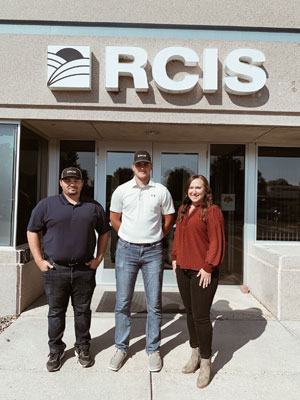 Alex Seibel (from left), Brandon Kroll and Emily Wolf will be the first crop apprentices to graduate from the Zurich Apprenticeship Program in September.
Alex Seibel (from left), Brandon Kroll and Emily Wolf will be the first crop apprentices to graduate from the Zurich Apprenticeship Program in September.
One apprentice, Emily Wolf, grew up on a farm in Washington state but moved to northern Idaho after high school. There, she worked at a restaurant and eventually as a manager at a sporting goods store. Years later, she returned to her hometown and was working at a fertilizer plant and found herself wanting to find a career.
She learned about Zurich's apprentice program when she applied for a job opening as an RCIS crop insurance adjuster.
“I've always loved agriculture, and I've always wanted to stay in it. I just couldn't find a way to, and this just seemed like the best opportunity,” Wolf said.
Wolf is part of Zurich’s first group of RCIS crop insurance apprentices, who are hired in different areas of Zurich’s business in 16 states. RCIS apprentices are located in states such as Idaho, Iowa, Minnesota, Nebraska, North Dakota, Ohio, South Dakota and Washington.
Wolf works three days per week and focuses on school for another two. Last year, Zurich began working with Northeast Iowa Community College in Calmar, Iowa, as the education provider for crop apprentices, who work toward an associate degree in agriculture business.
The program also matches apprentices with apprentice alumni advisers to help them navigate the dual responsibilities of work and school. Colton Wright serves as Wolf’s mentor along with two other crop apprentices on the adjuster path.
“We have every opportunity to be completely successful. That’s what I tell every apprentice I work with,” Wright said. “I don’t think there’s any job out there where they’re going to have this much support.”
Building tailored apprenticeship programs
States are also stepping in to create tailored apprenticeship opportunities for farms and businesses of all sizes.
Shonda Anderson, director of apprenticeship and internship for the Kansas Department of Commerce, worked with the Kansas Farm Bureau to launch the Rural Kansas Apprenticeship Program (RKAP).
Anderson said apprenticeships bring back a “renaissance of respect to skill trades.” For young people looking for a pathway into the agricultural space, the apprenticeship provides a full-time paid job on day one.
“The intent is mastery level training and mastery level understanding for an occupation,” Anderson said.
The program allows individuals to work with farmers, ranchers or rural businesses of any scale. RKAP builds programs that specifically meet that farmer or business’s needs at a very granular level, said Joel Leftwich, chief strategy officer at Kansas Farm Bureau.
In February, RKAP launched an apprenticeship program with Mid-Kansas Cooperative to hire agricultural equipment operators, CDL drivers and operations specialists. Anne Anderton Warren, MKC executive vice president and chief talent officer, said the program formalizes the training and opportunities that have existed at the cooperative for years. Apprentices will receive mentorship, training and compensation while developing skills in a high-demand agriculture career path.
“We believe that clarifying our commitment through this opportunity provides people with or without agricultural experience a clear path to a rewarding role in our organization,” Warren said.
The Kansas program requires a minimum of 2,000 hours of on-the-job training; some occupations will require as many as 8,000. It also requires a minimum of 144 hours per year of related technical instruction, either in-person or online, Anderson said.
“The completion of the apprenticeship program shows that the person didn’t just go to school; they didn’t just do these credentials. They also worked on the job and tracked every hour they were on the job learning. So that becomes a national-recognized credential in and of itself,” Anderson stated.
Attracting a more diverse workforce
Government agencies and companies that plan to stay ahead of workforce challenges are looking outside traditional ag circles. The generation entering the workforce seeks meaning in their work, which aligns well with workers with a non-agriculture background who can find purpose in many agricultural jobs.
“Thirty years ago, we had a 50% chance that the person's parents or grandparents had a farm. We've got a 2% chance today. So, we find ourselves with our education hat on a lot of times about what our company does,” said Mark Lowery, director of commercial marketing for New Holland Agriculture North America, which does not have a widely recognized brand outside of farm country.
Agriculture Secretary Tom Vilsack said the government has an important role to play in securing farm workers and workers in the processing industry, attracting and supporting beginning farmers and ranchers, transitioning employers to automation and finding new leaders to carry on the future of agriculture.
In June, with funding provided in the Inflation Reduction Act, USDA’s National Institute of Food and Agriculture announced a $262.5 million investment in a NextGen program to train and support more than 20,000 future food and agricultural leaders through 33 project partners in 24 states. USDA had to choose between 175 project proposals made by 117 eligible institutions, requesting a total of $1.5 billion.
 Ag Secretary Tom Vilsack speaks at a USDA event highlighting the next generation of the agricultural workforce.
“The expectation is that we’re going to invite young people to have experiences, training and education with the hope and the belief that they will find an opportunity in agriculture, in agribusinesses, at USDA,” Vilsack said. Over time, he hopes those who participate can take their life and learning experiences to become the leaders of USDA and agriculture.
Ag Secretary Tom Vilsack speaks at a USDA event highlighting the next generation of the agricultural workforce.
“The expectation is that we’re going to invite young people to have experiences, training and education with the hope and the belief that they will find an opportunity in agriculture, in agribusinesses, at USDA,” Vilsack said. Over time, he hopes those who participate can take their life and learning experiences to become the leaders of USDA and agriculture.
In August, USDA’s Rural Development announced a partnership with the Community College Alliance for Agriculture Advancement to provide Midwest students with rural economic development opportunities as well as resources and skill sets to help them advance in ag careers. As part of a memorandum of understanding, USDA will offer its staff expertise in over 400 offices around the country to provide guest lectures and assist with curricula to instill knowledge in the future ag workforce.
In an interview with Agri-Pulse, USDA Rural Development Deputy Undersecretary Farah Ahmad said the program marries the colleges' “training and education with our on-the-ground experience. When you combine those powers, you have a really strong training program for that next generation of rural leaders.”
USDA’s NextGen program works to reach out to underserved populations and builds on Vilsack’s desire to diversify the workforce.
“Agriculture has for many years been a predominantly white industry,” Vilsack said. “We really have to have an industry that reflects the diversity of the people we’re serving and understands the cultural differences and challenges and preferences that we all have.”
Scholarships, internships encourage additional experiences
To attract that diversity of applicants, companies are also offering additional support and assistance to potential employees. According to AgCareers.com, 50% of ag companies offer formalized on-the-job training, mentoring or coaching. External study with tuition reimbursement is on the rise, with 62% of companies now offering it, with another 38% providing certificate courses.
Many agribusinesses offer internships and job training opportunities to enhance the understanding of agriculture and their business. Bayer, for example, has its Emerging Talent Program, which includes 20 internships and 14 trainee positions to offer a broad exposure to different business units.
The internship program is typically three to four months, but the trainee position lasting 12-15 months is a full-time role with compensation at about 90% of a field sales representative. This also allows that individual to be mentored by a full-time employee.
Barry Scarbrough, Bayer’s North America training and development lead, said it’s not uncommon for the company to hire new employees who don’t have an agriculture background, so they’ve designed those 12-15 months to train new employees in both selling/negotiation soft skills in addition to agronomy basics.
Other companies, such as CHS, a Minnesota-based farmer cooperative, offer tuition reimbursement for additional certifications and training to address special skill needs, not just for use on a traditional bachelor's or associate degree. For example, CHS needs drivers that not only have a commercial license but also a hazmat endorsement and a minimum level of experience. The reimbursement can be used for training the drivers.
Establishing curriculum to target needs of industry
Farm organizations are also stepping in and working alongside community colleges and universities to develop curricula that will provide the needed education and skills.
The Western Growers Association received $750,000 in grant funding from the California Department of Food and Agriculture to develop educational modules for new certifications and degrees. The goal is to train 3,000 future employees in the next four years.
“With the new developments in automation, employees are having to be more skilled so that they can run and repair these types of equipment,” said Carrie Peterson, who serves as the next-generation ag worker grant manager at Western Growers. “We are trying to ensure these students learn the right ag tech skills while they’re still in school so that they can utilize those skills once they get out, and they’re a good candidate for these jobs.”
Designing a full course or certification program can be a multiyear process, but Peterson has been working with faculty at select community colleges to take newly developed modules on identified skill gaps that they can quickly integrate into their curriculum. With the grant money, Peterson said they’re reacting to skills gaps that currently exist as opposed to looking forward and training for the future because it’s a quicker turnaround with these modules to embed in existing courses.
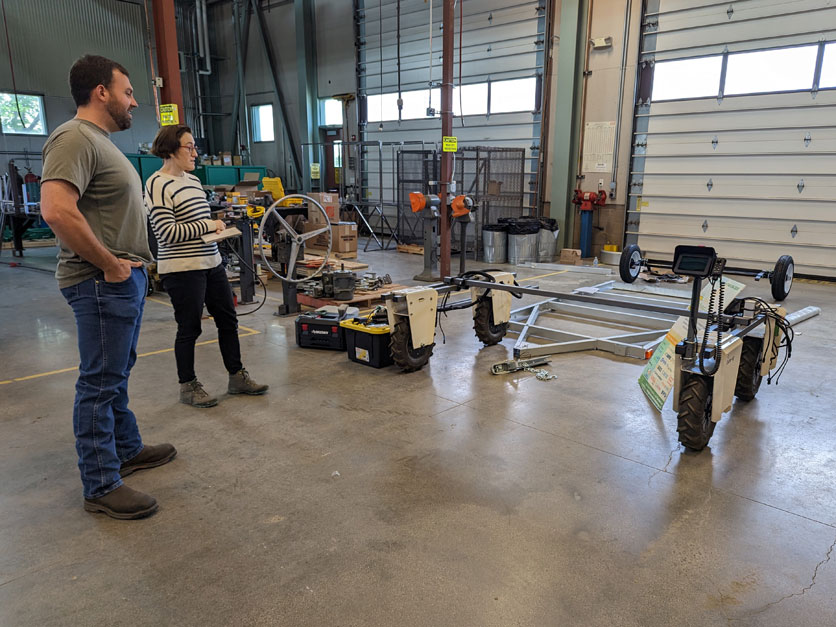 Agtech lab at Hartnell College - Alisal Campus (Photo: Western Growers)
Agtech lab at Hartnell College - Alisal Campus (Photo: Western Growers)Modules cover topics such as irrigation practices, programmable logic controllers, GPS and geospatial technologies, unmanned aerial systems, precision agriculture software skills and knowledge of local commodities. Peterson worked with 10 faculty from 10 different colleges ranging from Redding, California, down to the Imperial Valley to design the modules. Today 25 to 30 community colleges have integrated the modules into their coursework.
Western Growers also is using the grant to provide approximately 70 internships over the next three years through a $3,000 stipend to the host employer to offset the cost of the intern. Peterson works directly with faculty at the colleges in the area where growers are located to match potential student interns with that employer.
“This is a great pipeline for us to test potential employees for the future for full-time or year-round positions,” Peterson said.
Walt Duflock, vice president of innovation at Western Growers, said the group also is looking to create opportunities for high school students to take the modules and receive the certification.
One obvious candidate for the program is King City High School in the Central Valley where nearly half the student body of 700 students is a member of FFA.
“There’s no reason why an opportunistic kid taking the right steps in their junior or senior year of high school couldn’t walk out the door at 18 with the King City High School diploma and a Western Growers certificate,” Duflock said.
For more news, go to Agri-Pulse.com.


